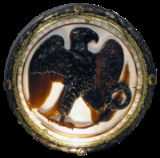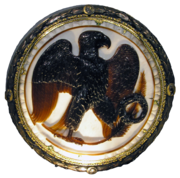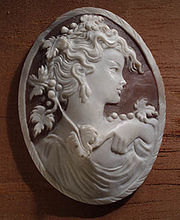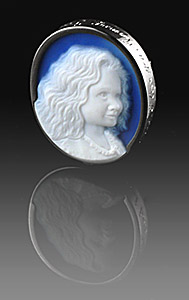
Cameo
Encyclopedia

Stone carving
Stone carving is an ancient activity where pieces of rough natural stone are shaped by the controlled removal of stone. Owing to the permanence of the material, evidence can be found that even the earliest societies indulged in some form of stone work....
an object such as an engraved gem, item of jewellery
Jewellery
Jewellery or jewelry is a form of personal adornment, such as brooches, rings, necklaces, earrings, and bracelets.With some exceptions, such as medical alert bracelets or military dog tags, jewellery normally differs from other items of personal adornment in that it has no other purpose than to...
or vessel made in this manner. It nearly always features a raised (positive) relief
Relief
Relief is a sculptural technique. The term relief is from the Latin verb levo, to raise. To create a sculpture in relief is thus to give the impression that the sculpted material has been raised above the background plane...
image; contrast with intaglio, which has a negative image. Originally, and still in discussing historical work, cameo only referred to works where the relief image was of a contrasting colour to the background; this was achieved by carefully carving a piece of material with a flat plane where two contrasting colours met, removing all the first colour except for the image to leave a contrasting background.
Today the term may be used very loosely for objects with no colour contrast, and other, metaphorical, terms have developed, such as cameo appearance
Cameo appearance
A cameo role or cameo appearance is a brief appearance of a known person in a work of the performing arts, such as plays, films, video games and television...
. This derives from another generalized meaning that has developed, the cameo as an image of a head in an oval
Oval
An oval is any curve resembling an egg or an ellipse, such as a Cassini oval. The term does not have a precise mathematical definition except in one area oval , but it may also refer to:* A sporting arena of oval shape** a cricket field...
frame in any medium, such as a photograph.
Technique
Ancient and Renaissance cameos were made from semi-precious gemstoneGemstone
A gemstone or gem is a piece of mineral, which, in cut and polished form, is used to make jewelry or other adornments...
s, especially the various types of onyx
Onyx
Onyx is a banded variety of chalcedony. The colors of its bands range from white to almost every color . Commonly, specimens of onyx contain bands of black and/or white.-Etymology:...
and agate
Agate
Agate is a microcrystalline variety of silica, chiefly chalcedony, characterised by its fineness of grain and brightness of color. Although agates may be found in various kinds of rock, they are classically associated with volcanic rocks and can be common in certain metamorphic rocks.-Etymology...
, and any other stones with a flat plane where two contrasting colours meet; these are "hardstone" cameos. In cheaper modern work, shell
Mollusc shell
The mollusc shell is typically a calcareous exoskeleton which encloses, supports and protects the soft parts of an animal in the phylum Mollusca, which includes snails, clams, tusk shells, and several other classes...
and glass
Glass
Glass is an amorphous solid material. Glasses are typically brittle and optically transparent.The most familiar type of glass, used for centuries in windows and drinking vessels, is soda-lime glass, composed of about 75% silica plus Na2O, CaO, and several minor additives...
are more common. Glass cameo
Cameo Glass
Cameo glass is a luxury form of glass art produced by etching and carving through fused layers of differently colored glass to produce designs, usually with white opaque glass figures and motifs on a dark-colored background...
vessels, such as the famous Portland Vase
Portland Vase
The Portland Vase is a Roman cameo glass vase, currently dated to between AD 5 and AD 25, which served as an inspiration to many glass and porcelain makers from about the beginning of the 18th century onwards. Since 1810 the vase has been kept almost continuously in the British Museum in London...
, were also developed by the Romans.
Modern cameos can be produced by setting a carved relief, such as a portrait, onto a background of a contrasting colour. This is called an assembled cameo. Alternatively, a cameo can be carved by the traditional, but far more difficult, method directly out of a material with integral layers or banding, such as (banded) agate
Agate
Agate is a microcrystalline variety of silica, chiefly chalcedony, characterised by its fineness of grain and brightness of color. Although agates may be found in various kinds of rock, they are classically associated with volcanic rocks and can be common in certain metamorphic rocks.-Etymology...
or layered glass, where different layers have different colours.
Sometimes dyes are used to enhance these colours.
History

Greece
Greece , officially the Hellenic Republic , and historically Hellas or the Republic of Greece in English, is a country in southeastern Europe....
dating back as far as the 3rd century BC. The Farnese Tazza (a cup) is the oldest major Hellenistic piece surviving. They were very popular in Ancient Rome
Ancient Rome
Ancient Rome was a thriving civilization that grew on the Italian Peninsula as early as the 8th century BC. Located along the Mediterranean Sea and centered on the city of Rome, it expanded to one of the largest empires in the ancient world....
, especially in the family circle of Augustus
Augustus
Augustus ;23 September 63 BC – 19 August AD 14) is considered the first emperor of the Roman Empire, which he ruled alone from 27 BC until his death in 14 AD.The dates of his rule are contemporary dates; Augustus lived under two calendars, the Roman Republican until 45 BC, and the Julian...
. The most famous stone "state cameos" from this period are the Gemma Augustea
Gemma Augustea
The Gemma Augustea is a low-relief cameo engraved gem cut from a double-layered Arabian onyx stone. It is commonly agreed that the gem cutter who created the Gemma Augustea was either Dioscurides or one of his disciples, in the second or third decade of the 1st century AD.- Creation and...
, the Gemma Claudia
Gemma Claudia
The Gemma Claudia is a Roman five-layered onyx cameo of c.49. It later found its way into the Habsburg collections now in the Kunsthistoriches Museum, Vienna . It is 12 cm high and set in a gold rim....
made for the Emperor Claudius
Claudius
Claudius , was Roman Emperor from 41 to 54. A member of the Julio-Claudian dynasty, he was the son of Drusus and Antonia Minor. He was born at Lugdunum in Gaul and was the first Roman Emperor to be born outside Italy...
, and the largest flat engraved gem known from antiquity, the Great Cameo of France
Great Cameo of France
The Great Cameo of France is a five-layered sardonyx cameo of circa 23 AD. It is 31 cm by 26.5 cm. It is first attested in the first inventory of the treasure of Sainte Chapelle before 1279...
.
The technique has since enjoyed periodic revivals, notably in the early Renaissance
Renaissance
The Renaissance was a cultural movement that spanned roughly the 14th to the 17th century, beginning in Italy in the Late Middle Ages and later spreading to the rest of Europe. The term is also used more loosely to refer to the historical era, but since the changes of the Renaissance were not...
, and again in the 18th and 19th centuries. The Neoclassical
Neoclassicism
Neoclassicism is the name given to Western movements in the decorative and visual arts, literature, theatre, music, and architecture that draw inspiration from the "classical" art and culture of Ancient Greece or Ancient Rome...
revival began in France with Napoleon's support of the glyptic arts, and even his coronation crown was decorated with cameos.
In Britain, this revival first occurred during King George III's reign, and his granddaughter, Queen Victoria, was a major proponent of the cameo trend, to the extent that they would become mass produced by the second half of the 19th century.
The visual art form of the cameo has even inspired at least one writer of more recent times, the 19th-century Russian poet Lev Mei, who composed a cycle of six poems entitled (Cameos, 1861), as reflections on each of the Roman rulers from Julius Caesar
Julius Caesar
Gaius Julius Caesar was a Roman general and statesman and a distinguished writer of Latin prose. He played a critical role in the gradual transformation of the Roman Republic into the Roman Empire....
to Nero
Nero
Nero , was Roman Emperor from 54 to 68, and the last in the Julio-Claudian dynasty. Nero was adopted by his great-uncle Claudius to become his heir and successor, and succeeded to the throne in 54 following Claudius' death....
. In 1852 Théophile Gautier
Théophile Gautier
Pierre Jules Théophile Gautier was a French poet, dramatist, novelist, journalist, art critic and literary critic....
titled a collection of his highly polished, lapidary poems Emaux et Camées (Enamels and Cameos).
Roman glass cameos
During the Roman periodRoman glass
Roman glass objects have been recovered across the Roman Empire in domestic, industrial and funerary contexts. Glass was used primarily for the production of vessels, although mosaic tiles and window glass were also produced. Roman glass production developed from Hellenistic technical traditions,...
the cameo technique was used on artificial glass blanks, in imitation of objects being produced in agate or sardonyx. Cameo glass
Cameo Glass
Cameo glass is a luxury form of glass art produced by etching and carving through fused layers of differently colored glass to produce designs, usually with white opaque glass figures and motifs on a dark-colored background...
objects were produced in two periods; between around 25 BC and 50/60 AD, and in the later Empire around the mid-third and mid-fourth century. Roman glass cameos are rare objects, with only around two hundred fragments and sixteen complete pieces known, only one of which dates from the later period. During the early period they usually consisted of a blue glass base with a white overlying layer, but those made during the later period usually have a colourless background covered with a translucent coloured layer. Blanks could be produced by fusing two separately cast sheets of glass, or by dipping the base glass into a crucible of molten overlay glass during blowing
Glassblowing
Glassblowing is a glassforming technique that involves inflating molten glass into a bubble, or parison, with the aid of a blowpipe, or blow tube...
. The most famous example of a cameo from the early period is the Portland Vase
Portland Vase
The Portland Vase is a Roman cameo glass vase, currently dated to between AD 5 and AD 25, which served as an inspiration to many glass and porcelain makers from about the beginning of the 18th century onwards. Since 1810 the vase has been kept almost continuously in the British Museum in London...
.
Shell cameos

Renaissance
The Renaissance was a cultural movement that spanned roughly the 14th to the 17th century, beginning in Italy in the Late Middle Ages and later spreading to the rest of Europe. The term is also used more loosely to refer to the historical era, but since the changes of the Renaissance were not...
, in the 15th and 16th centuries. Before that time, cameos were carved from hardstone. The Renaissance cameos are typically white on a grayish background and were carved from the shell of a mussel
Mussel
The common name mussel is used for members of several families of clams or bivalvia mollusca, from saltwater and freshwater habitats. These groups have in common a shell whose outline is elongated and asymmetrical compared with other edible clams, which are often more or less rounded or oval.The...
or cowry
Cowry
Cowry, also sometimes spelled cowrie, plural cowries, is the common name for a group of small to large sea snails, marine gastropod molluscs in the family Cypraeidae, the cowries...
, the latter a tropical mollusk.
In the mid 18th century, explorations revealed new shell varieties. Helmet shells (Cassis tuberosa
Cassis tuberosa
Cassis tuberosa, common name the king helmet, is a species of very large sea snail with a solid heavy shell, a marine gastropod mollusc in the family Cassidae, the helmet shells and their allies.- Distribution :...
) from the West Indies, and queen conch shells (Eustrombus gigas) from the Bahamas
The Bahamas
The Bahamas , officially the Commonwealth of the Bahamas, is a nation consisting of 29 islands, 661 cays, and 2,387 islets . It is located in the Atlantic Ocean north of Cuba and Hispaniola , northwest of the Turks and Caicos Islands, and southeast of the United States...
and West Indies, arrived in Europe. This sparked a big increase in the number of cameos that were carved from shells. Conch shells carve very well, but their color fades over time.
After 1850 demand for cameos grew, as they became popular souvenirs of the Grand Tour
Grand Tour
The Grand Tour was the traditional trip of Europe undertaken by mainly upper-class European young men of means. The custom flourished from about 1660 until the advent of large-scale rail transit in the 1840s, and was associated with a standard itinerary. It served as an educational rite of passage...
among the middle class.
Cameo subjects
Classically the designs carved onto cameo stones were either scenes of Greek or Roman mythology or portraits of rulers or important dignitaries. In history, agate portrait cameos were often gifts from royalty to their subjects. These antique cameos, some more than 2000 years old, are either displayed in museums or are in private collections.Notable historic cameos

Gemma Augustea
The Gemma Augustea is a low-relief cameo engraved gem cut from a double-layered Arabian onyx stone. It is commonly agreed that the gem cutter who created the Gemma Augustea was either Dioscurides or one of his disciples, in the second or third decade of the 1st century AD.- Creation and...
Cameo – Roman, After 10 A. D. Two-Layered onyx
"Tazza Farnese" An ancient hellenistic bowl made of a very large cameo and purchased by Lorenzo de' Medici
Lorenzo de' Medici
Lorenzo de' Medici was an Italian statesman and de facto ruler of the Florentine Republic during the Italian Renaissance. Known as Lorenzo the Magnificent by contemporary Florentines, he was a diplomat, politician and patron of scholars, artists and poets...
during the Italian Renaissance
Italian Renaissance
The Italian Renaissance began the opening phase of the Renaissance, a period of great cultural change and achievement in Europe that spanned the period from the end of the 13th century to about 1600, marking the transition between Medieval and Early Modern Europe...
.
Cup of the Ptolemies
Cup of the Ptolemies
The Cup of the Ptolemies is an onyx or chalcedony cameo two-handled cup , now conserved in the Cabinet des Médailles at the Bibliothèque National, Paris. Until September 1791 it formed part of the treasury of the Basilica of Saint-Denis. It was stolen in 1804, and recovered without its...
a large Roman or Hellenistic vessel.
Portland Vase
Portland Vase
The Portland Vase is a Roman cameo glass vase, currently dated to between AD 5 and AD 25, which served as an inspiration to many glass and porcelain makers from about the beginning of the 18th century onwards. Since 1810 the vase has been kept almost continuously in the British Museum in London...
, the best known piece of cameo glass.
Great Cameo of France
Great Cameo of France
The Great Cameo of France is a five-layered sardonyx cameo of circa 23 AD. It is 31 cm by 26.5 cm. It is first attested in the first inventory of the treasure of Sainte Chapelle before 1279...
– Roman, circa 23 A.D. Sardonyx.
Gemma Claudia Cameo – Roman, 49 A.D. Five-layered onyx
Herophiloska Cameo – Roman, 14 to 37 AD
This portrait of a man with laurel wreath is probably of Emperor Tiberius. The work is signed "Herophilos Dioskourid[ou] ("Herophilus, son of Dioscorides). The colour of the glass was intended by the artist to imitate turquoise.
"Gonzaga Cameo
Gonzaga Cameo
Il Cammeo Gonzaga is a Hellenistic engraved gem; a cameo of the capita jugata variety cut out from the three layers of an Indian sardonyx, dating from perhaps the 3rd Century BC. It was a centrepiece of the Gonzaga collection of antiquities, first described in a 1542 inventory of Isabella d'Este's...
" Ptolemy II and Arsinoë II.
Sardonyx. 3rd century B.C.
Agrippina the Elder Cameo-Carved in Italy in the period of 37 – 41 AD. The carving is a three layer agate.
Ptolemaic double cameo-Hellenistic, 278–270/269 B. C. Eleven-layered onyx;
"Blacas Cameo"-Roman, about AD 14–20. This was carved from a three layered sardonyx. It is a fragment of a larger portrait of the Roman emperor-Augustus.
"The head of Flora Cameo" – Benedetto Pistrucci
Benedetto Pistrucci
Benedetto Pistrucci was a distinguished Italian Gem-engraver, medallist and coin-engraver who became Chief-medallist at the Royal Mint in England.-Early life, training and career:...
. AD 1812 In this cameo the top red-brown layer has been carved into roses. The face is carved from the white layer. The collector Richard Payne Knight purchased the Flora cameo from an Italian dealer, believing it to be Roman. The Italian carver Pistrucci claimed to have carved it himself. Payne challenged Pistrucci to carve a copy to prove his claim. The ensuing publicity earned Pistrucci several commissions.
Modern cameos

Ultrasonic machine carved cameos
The majority of modern agate cameos are carved with the aid of the Ultrasonic Mill. This is a process where multiple copies of a master design can be produced very quickly by pressing a master die onto the agate cameo blank. A film of diamond slurry is used to aid cutting and the die vibrates ultrasonically in a vertical motion. The master is often hand carved by a skilled cameo artist.The result is a cameo that has a satin surface texture described as "freshly fallen snow", (FSS) by Anna Miller. This texture and the lack of any undercutting are used by appraisers as markers to prove that the cameo is machine-made.
Hand-worked portrait cameos
These cameos are carved by hand usually working from photographs of the subject. The fact that there is usually only one copy made means that the tooling costs involved rule out the ultrasonic carving process.There are very few people working in this field as this is one of the hardest challenges for any gemstone carver. The combination of a highly developed artistic ability, craft skill and many years of experience are needed to be able to create life-like portraits.
It is quite rare, these days, for subjects other than portraits to be carved by hand as agate cameos. The traditional themes of classical scenes from mythology or a standard image of a young lady, are more likely to be made with the help of the ultrasonic carving machine as a limited collection of typically 50 – 200 pieces.
Shell cameos
Since the late 19th century, the species most used in good quality cameos has been Cypraecassis rufaCypraecassis rufa
Cypraecassis rufa is a species of large sea snail, a marine gastropod mollusk in the family Cassidae. It is commonly known as the bullmouth or red helmet shell, and also as the cameo shell.-Distribution:...
, the bullmouth helmet, the shell of which can be up to 6 inches long. In this species, the upper shell layer is whitish, and the lower shell layer is a rich orange-brown. Modern sources for this shell are Madagascar
Madagascar
The Republic of Madagascar is an island country located in the Indian Ocean off the southeastern coast of Africa...
and South Africa
South Africa
The Republic of South Africa is a country in southern Africa. Located at the southern tip of Africa, it is divided into nine provinces, with of coastline on the Atlantic and Indian oceans...
. The finest hand-carving of these shells takes place in Italy
Italy
Italy , officially the Italian Republic languages]] under the European Charter for Regional or Minority Languages. In each of these, Italy's official name is as follows:;;;;;;;;), is a unitary parliamentary republic in South-Central Europe. To the north it borders France, Switzerland, Austria and...
.
The most highly prized shell for carving is the emperor helmet shell, Cassis madagascariensis
Cassis madagascariensis
Cassis madagascariensis is a species of very large sea snail, a marine gastropod mollusc in the family Cassidae, the helmet shells and bonnet shells.-Distribution:This species occurs in the tropical Western Atlantic...
. This shell has white and dark brown layers and is known as sardonyx shell, and looks similar to the layered agate known as sardonyx.
The world center for cameo carving in shell is Torre del Greco
Torre del Greco
-Main sights:*Roman archaeological remains, including the so-called "Villa Sora" , probably a property of the Flavians.*Monastery of the Zoccolanti, with a cloister housing 28 frescoed panels depicting the life of St...
, Italy. The shells are first marked with a series of ovals in a process called signing, then cut into oval blanks for the cameo carver. The actual cameo is mainly cut with a metal scraping tool called a bulino, an invention of Jewish artisan Antonio Cimeniello. A number of metal gravers are used: flat-faced, round and three-cornered. To speed production, grinding wheels are used to quickly remove excess material. When the details are completed, the shell is then soaked in olive oil, cleaned with soap and water and selectively polished with a hand brush.
Cameo proof coins
In numismaticsNumismatics
Numismatics is the study or collection of currency, including coins, tokens, paper money, and related objects. While numismatists are often characterized as students or collectors of coins, the discipline also includes the broader study of money and other payment media used to resolve debts and the...
, cameo refers to a proof
Proof coinage
Proof coinage means special early samples of a coin issue, historically made for checking the dies and for archival purposes, but nowadays often struck in greater numbers specially for coin collectors . Many countries now issue them....
coin
Coin
A coin is a piece of hard material that is standardized in weight, is produced in large quantities in order to facilitate trade, and primarily can be used as a legal tender token for commerce in the designated country, region, or territory....
that has frost
Frosting (decorative arts)
A decorative art technique based on the climatatogical nature of frost is the technique of Frosting.-Examples of ancient Egyptian steles:Eventually Ancient Egyptian steles became more than just statements about a topic or events, and became a means of decoration. Later period steles were made in...
ed lettering and features, providing attractive contrast with the mirrored fields of the coin. The terms "deep cameo" and "ultra cameo" describe cameo coins having the boldest, most attractive contrast.
External links
- Cameo Appearances Exhibition at The Metropolitan Museum of Modern Art, 2004
- Cameo collection at the Kunsthistorisches Museum Vienna | Gemma Augusta, Gemma Claudia, Herophiloska Cameo
- Antique Cameos in the Hermitage Museum
- How a portrait cameo in layered agate is made
- Gareth Eckley (cameo-artist)
- August Rudolf Wild 1891-1956, Gemmenschneider (cameo-artist)
- Gerhard Schmidt, Gemmenschneider (cameo-artist)
- Coral and Cameos Museum, Naples

